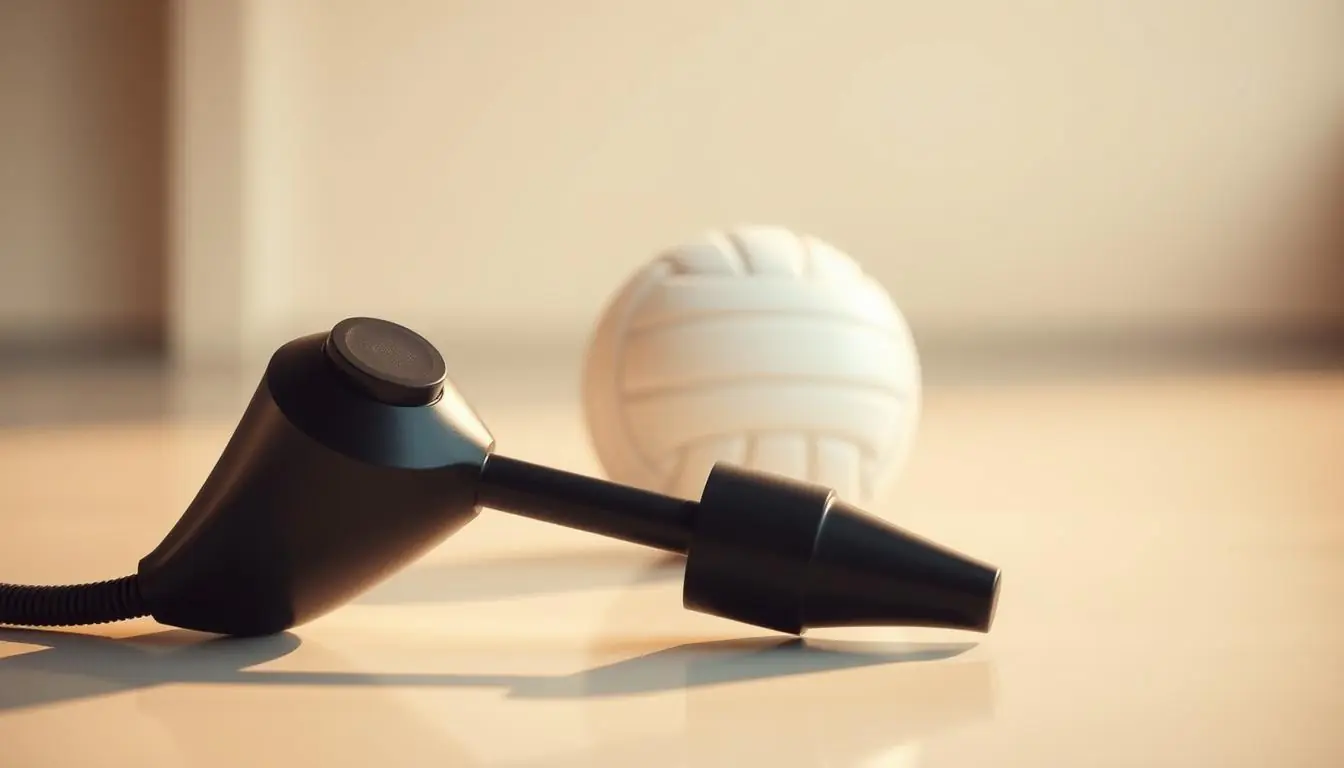Every volleyball player knows a perfectly inflated ball is key. I remember my first tournament, seeing a teammate struggle with a ball that moved slowly. That moment taught me the importance of mastering the volleyball ball pump.
In volleyball, precision is everything. Whether practicing or in a big match, knowing how to inflate your ball right can change the game. This guide will show you how to use a volleyball ball pump, from choosing the right one to getting the air pressure just right.
Key Takeaways
- Learn the essential steps to inflate a volleyball correctly
- Understand the importance of proper ball inflation
- Discover different types of volleyball ball pumps
- Prevent common inflation mistakes
- Maintain optimal volleyball performance through proper inflation
Understanding Volleyball Ball Pumps
Choosing the right volleyball ball pump is key for the best ball performance. There are different types of pumps, each with its own benefits for players and coaches.
Players have many options when it comes to volleyball pumps. Each design meets specific needs and conditions.
Pump Varieties for Volleyball Players
- Hand Pumps: Basic manual inflation option
- Double Action Hand Pumps: Inflate on push and pull strokes
- Stirrup Pumps: Provide mechanical leverage for easier inflation
- Heavy-Duty Stirrup Pumps: Designed for frequent use
- Electric Pumps: Quick and effortless inflation
Essential Ball Pump Components
Knowing about ball pump parts is important. The main parts are the pump body, inflation needle, pressure gauge, and air hose.
| Component | Function | Average Cost |
|---|---|---|
| Pump Body | Creates air pressure | $10-$20 |
| Inflation Needle | Connects pump to ball valve | $2-$5 |
| Pressure Gauge | Monitors air pressure | $5-$15 |
Benefits of Proper Pump Selection
Choosing the right pump keeps ball pressure consistent. This helps your equipment last longer and play better. Electric pumps can inflate balls in 15-45 seconds. Manual pumps take 30-60 seconds.
For volleyball fans, a good pump means your balls are always ready. It’s all about game prep.
Proper Volleyball Air Pressure Requirements
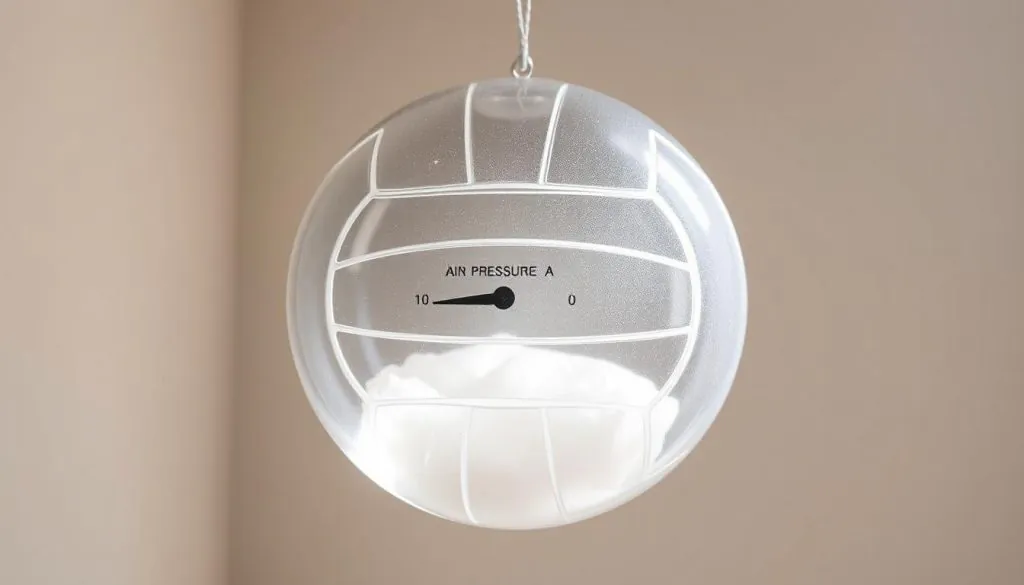
Getting the right volleyball air pressure is key for top performance. As a volleyball fan, I’ve found that the right inflation level is essential. It can greatly affect your game.
Different volleyballs need specific air pressure levels:
- Indoor volleyballs: 4.3 to 4.6 psi
- Beach volleyballs: 2.5 to 3.2 psi
Knowing the right air pressure helps players control the ball better. An under-inflated ball can mess up your serve and ball control.
It’s smart to check your volleyball’s air pressure often. Use a good pressure gauge. Here are signs of the right air pressure:
- Consistent bounce
- Smooth surface tension
- Predictable ball movement
Professional players focus on the right air pressure for the best game. Whether practicing or competing, the right inflation ensures top performance and comfort.
Pro tip: Always test your volleyball’s pressure before big matches to ensure the best play conditions.
Essential Equipment for Ball Inflation
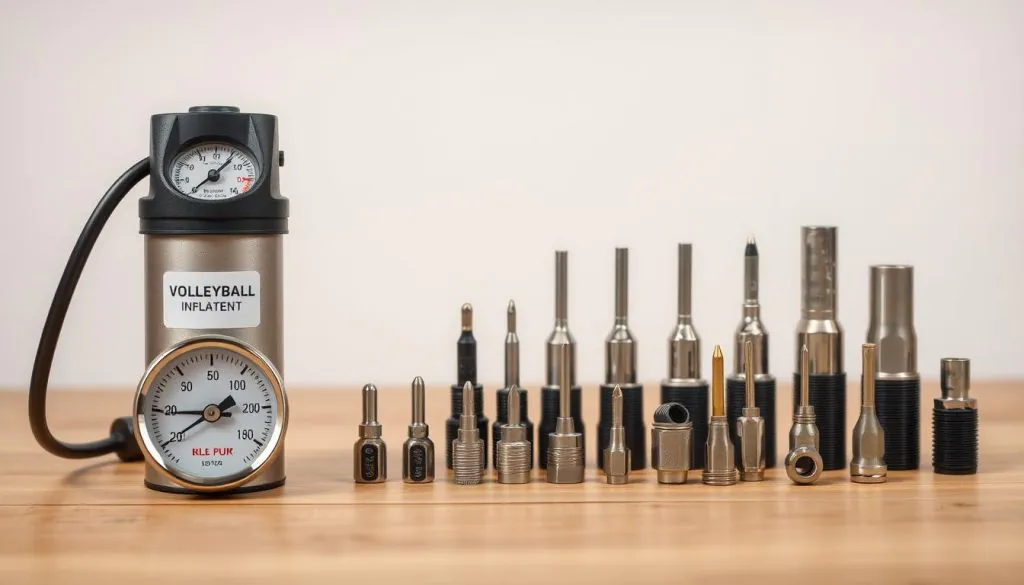
Choosing the right volleyball inflation equipment is key to getting ready for the game. I’ll show you the must-have tools and tech for perfectly inflated volleyballs every time.
Quality Pump Selection
Finding the right pump is vital for top volleyball performance. I suggest using digital pumps like the FORZA Digital Ball Pump. It provides accurate inflation:
- Maximum pressure of 12 PSI
- Rapid inflation rate of 4 liters per minute
- Complete ball inflation in just over 1 minute
Needle Attachments and Adapters
Having versatile ball pump accessories is key for different valve types. The best pump should have many needle attachments for various volleyball designs.
| Pump Accessory | Specification |
|---|---|
| Ball Needles | 2 USA standard needles |
| Inflatable Needle | 1 multi-purpose needle |
| Additional Components | Flexi hose, carry case |
Pressure Gauge Importance
A precise pressure gauge is essential for volleyball inflation. The FORZA pump has a clear LED digital display for exact pressure control. For volleyballs, the ideal inflation is 6 PSI.
“Accurate inflation is the key to consistent volleyball performance.” – Professional Volleyball Coach
With these advanced ball pump accessories, your volleyball will always be ready for the game. It will have the best bounce and playability.
Step-by-Step Volleyball Ball Pump Guide
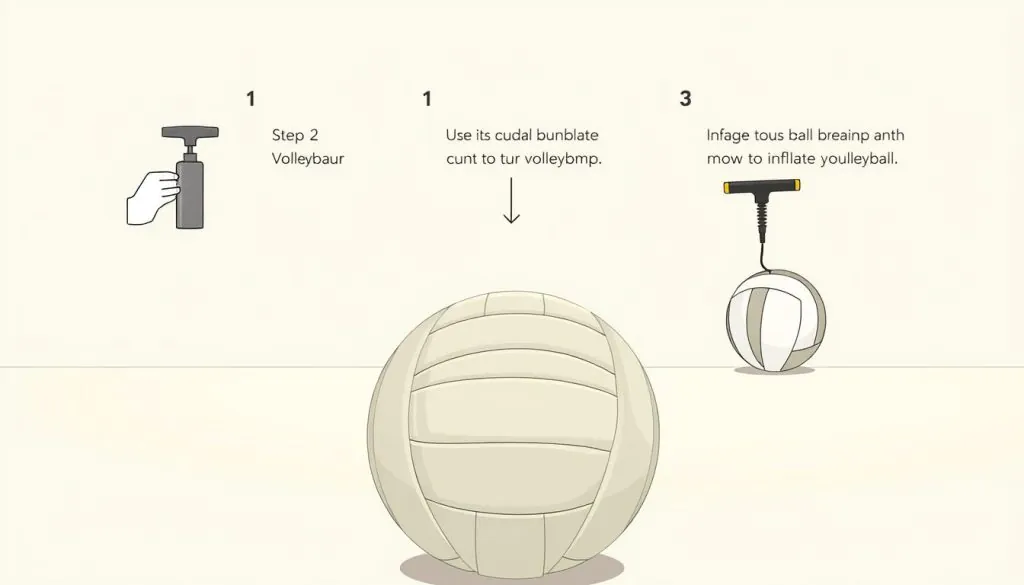
Inflating a volleyball needs care and the right tools. I’ll show you how to use a ball pump to get your volleyball ready to play.
First, make sure you have these important items:
- Ball pump with the right needle
- Lubricant (water or special valve lubricant)
- Pressure gauge
Here’s how to inflate a volleyball:
- Check the Valve: Find the valve near the size info on the volleyball
- Lightly lubricate the valve with water to help the needle go in
- Pick the correct needle size for your volleyball
- Put the needle in gently at a 90-degree angle
- Start adding air, watching the pressure gauge closely
The perfect pressure for a volleyball is between 4.3 to 4.6 psi. Smart pumps like the Torx model have digital displays for better accuracy. Manual pumps require you to watch the pressure yourself.
Pro tip: Inflate slowly and evenly to avoid overinflating. Some pumps have auto-stop features to stop at the right pressure.
Smart Ball Pump Technology Features
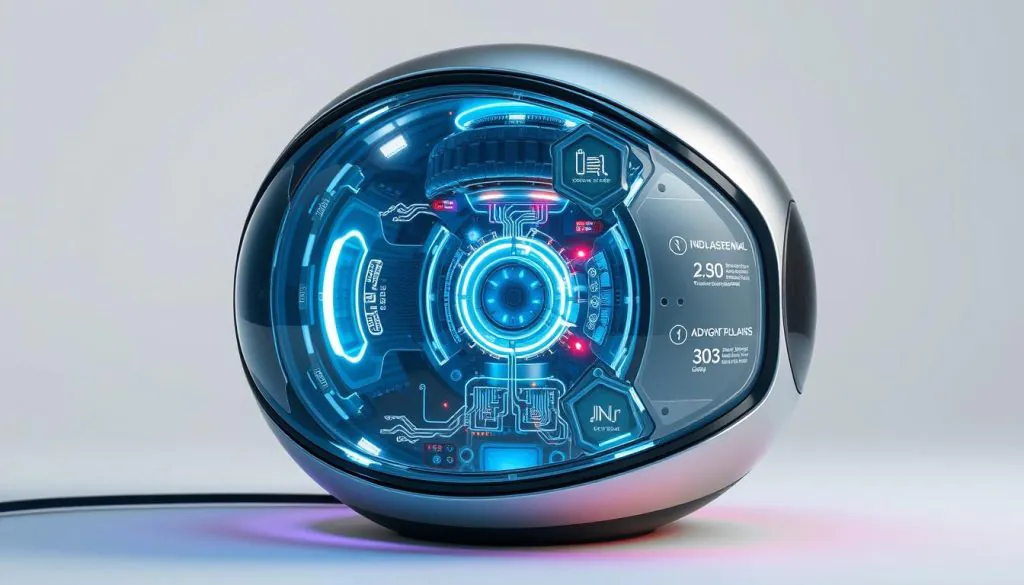
Modern volleyball equipment has entered a new era with advanced digital ball pump technology. These smart volleyball pumps are changing how athletes prepare their equipment. They offer precision and convenience like never before.
I’ll show you the advanced features of these digital ball pumps. They are a game-changer for volleyball players and sports fans.
Digital Pressure Display
The digital pressure display is a key feature of smart volleyball pumps. It gives precise electronic readings. This lets you:
- Monitor exact inflation levels in real-time
- Ensure consistent ball pressure
- Avoid over or under-inflation
Preset Pressure Settings
Smart digital ball pumps have preset pressure settings. These settings let you:
- Select recommended PSI for different sports
- Save time during equipment preparation
- Maintain standardized ball inflation
| Sport | Recommended PSI |
|---|---|
| Volleyball | 6 PSI |
| Basketball | 7-9 PSI |
| Football | 8-12 PSI |
Battery Life and Charging
The latest smart volleyball pumps have impressive battery life. The FORZA Digital Electric Pump, for example, has:
- 2000mAh lithium-ion battery
- Charging time: 2.5 hours
- Up to 40 ball inflations per charge
- Maximum working time: 30-40 minutes
These advanced digital ball pumps give athletes reliable, efficient, and precise inflation technology. This is for optimal performance.
Maintaining Your Volleyball Ball Pump
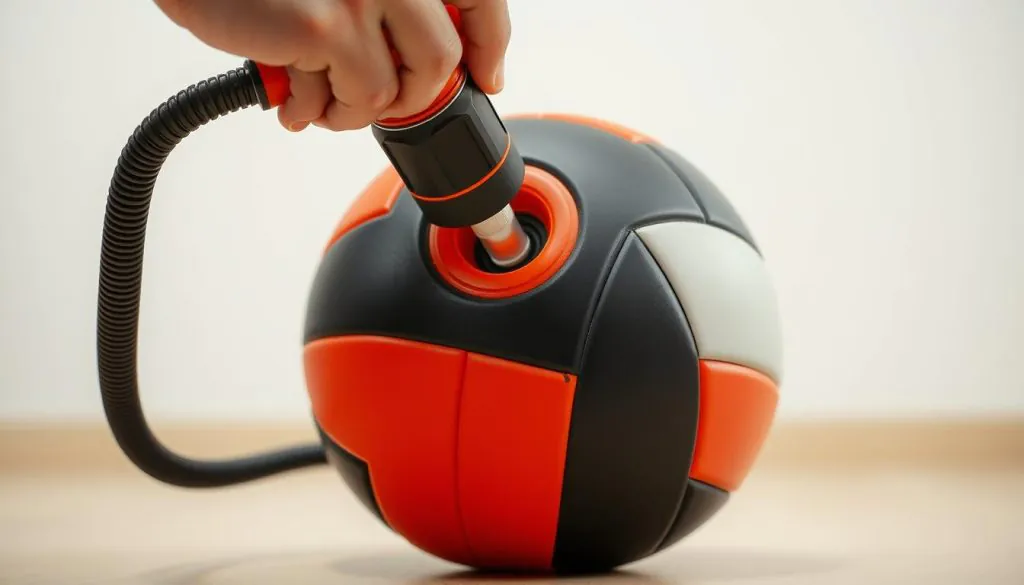
Keeping your volleyball ball pump in good shape is key. By following these tips, you can make your pump last longer and work better.
Regular care is important to protect your investment. Here are the best ways to keep your pump in top condition:
- Clean the pump body after each use with a soft, dry cloth
- Inspect the needle for any signs of wear or damage
- Store the pump in a cool, dry place away from direct sunlight
- Lubricate moving parts periodically with recommended silicone-based lubricant
Manual pumps need extra attention. Always check the seals and connections to avoid air leaks. Electric pumps also need care for battery maintenance and charging connections.
| Maintenance Task | Frequency | Purpose |
|---|---|---|
| Needle Inspection | Before/After Each Use | Prevent Damage |
| External Cleaning | After Each Use | Remove Dirt/Moisture |
| Lubrication | Every 3-4 Months | Maintain Moving Parts |
Look out for signs that your pump might need to be replaced. These include trouble with air pressure, hard inflation, or visible damage. Spending a little time on maintenance can save you money and ensure you’re ready for your next game.
Troubleshooting Common Pump Issues
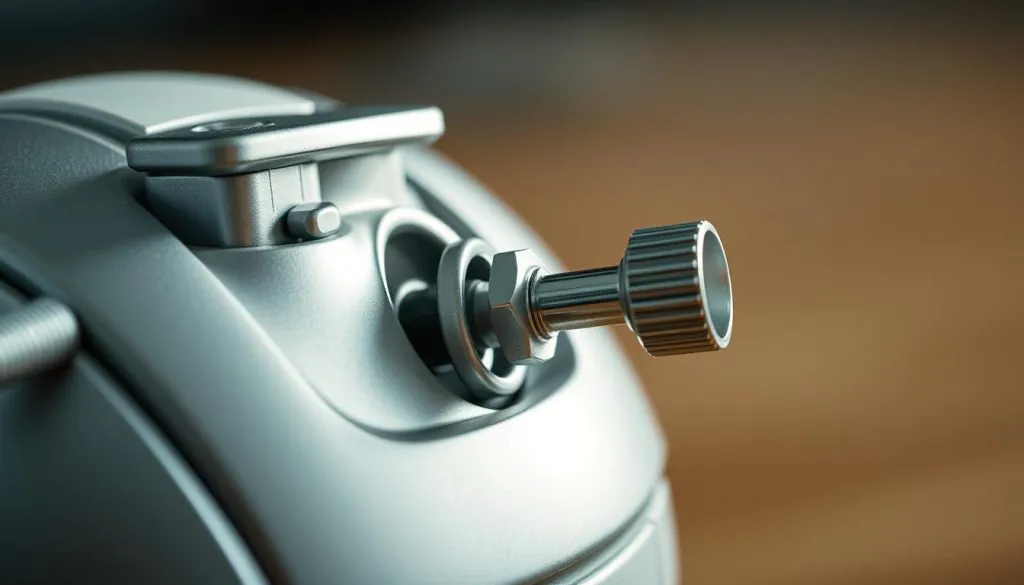
Volleyball pump troubleshooting can save you time and frustration. Even the best equipment can have problems. I’ll show you how to fix common pump issues to keep your volleyball ready.
Air Leakage Solutions
When you face air leakage in your volleyball ball pump, start by checking these key areas:
- Inspect the pump’s rubber seals for cracks or wear
- Ensure the needle is correctly inserted and not damaged
- Check for loose connections between pump components
- Verify the valve’s integrity on both the pump and volleyball
To fix ball pump issues related to air leaks, clean the needle and valve area before each use. Replace worn-out parts promptly to maintain optimal performance.
Pressure Gauge Accuracy
Inaccurate pressure readings can affect your volleyball’s performance. Watch for these warning signs:
- Inconsistent inflation levels
- Stuck or unresponsive gauge needle
- Visible physical damage to the gauge
Consider calibrating or replacing the pressure gauge if you notice persistent measurement problems. A reliable gauge is key for perfect volleyball inflation.
Needle Complications
Needle issues can quickly ruin your volleyball preparation. Common problems include:
- Bent or misaligned needles
- Corrosion or rust on needle attachments
- Damaged needle threading
Always store your pump needle in a clean, dry place. Use a light lubricant to prevent corrosion. Replace needles that show signs of significant wear for smooth, reliable inflation.
Safety Precautions and Best Practices
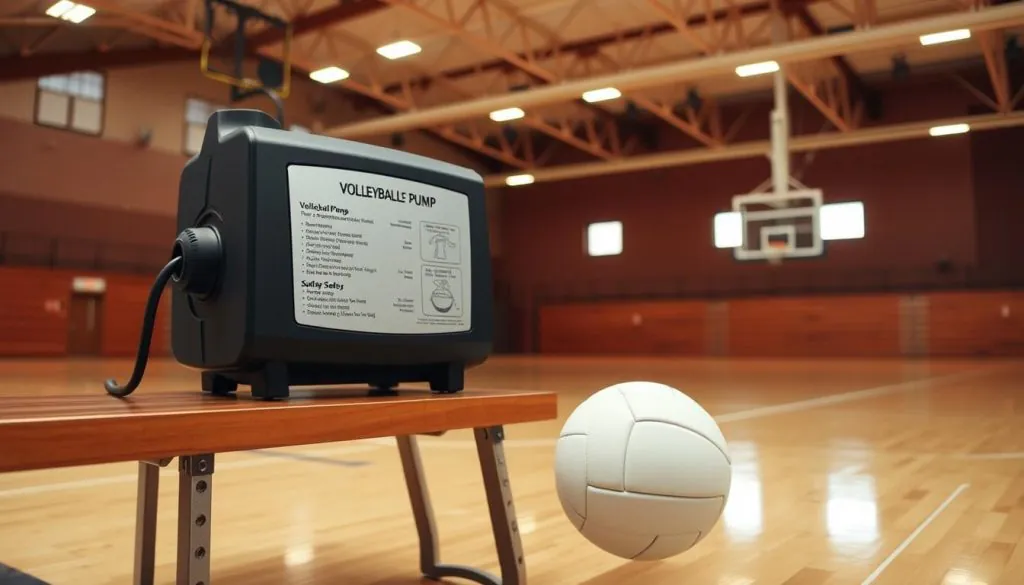
Volleyball pump safety is very important. I’ve worked with volleyball equipment for years. I know how key it is to follow the right steps to avoid damage and injuries.
Here are some important safety tips for using a volleyball ball pump:
- Always watch the inflation process closely
- Keep pumps away from flammable materials
- Protect equipment from moisture and extreme temperatures
- Check the pump and needle before each use
Electric pump users need to be extra careful. Avoid tugging on cords or placing pumps near water sources. With over 460,000 high school students playing volleyball, it’s vital to handle equipment right.
Here are some specific safety tips for volleyball pumps:
- Use the correct needle size for your volleyball
- Insert needles gently to prevent damage
- Never overinflate the ball beyond recommended pressure
- Store pumps in cool, dry locations
Volleyball injuries affect about 14% of female players each year. So, it’s as important to take care of equipment as it is to practice techniques. Properly managing the inflation process can prevent risks.
Safety isn’t just about technique—it’s about mindful preparation and consistent care.
Conclusion
This guide has shown you how to inflate your volleyball ball right. Knowing the correct pressure and using the right tips can really boost your game. Whether it’s for indoor or beach volleyball, getting the ball pressure just right is key.
Electric ball pumps have changed how we get our gear ready. They inflate fast and let you check the pressure easily. This makes sure your volleyball is always at its best.
Using the tips from this guide will make you a pro at inflating your ball. Remember, indoor balls need 4.3 to 4.6 psi, while beach balls need a bit less. Paying attention to these details will keep you ready for any game.
Keep practicing these tips, and get good equipment. You’ll see a big difference in your game. Stay consistent, stay ready, and have fun on the court!
FAQ
What’s the difference between manual and electric volleyball ball pumps?
Manual pumps need you to pump them by hand. They’re cheaper and easy to carry. Electric pumps inflate balls automatically and are quicker, but they cost more and need power.
How often should I check the air pressure in my volleyball?
Check your volleyball’s air pressure before each game or practice. Balls lose air over time. Keeping the pressure right is key for good play and control.
What’s the recommended air pressure for indoor and beach volleyballs?
Indoor volleyballs need 4.3 to 4.6 PSI. Beach volleyballs should be at 2.5 to 3.2 PSI. Always check the maker’s guide for the exact pressure.
Can I use the same pump for different types of sports balls?
Many pumps have different needles for different balls. But, it’s best to use a pump made for volleyballs. Each ball needs its own pressure and valve type to inflate right.
How do I know if my volleyball is over or under-inflated?
A too-hard ball bounces too high. A soft ball bounces less. A pressure gauge helps keep the ball at the right pressure.
What should I do if my pump needle gets stuck or damaged?
Replace a bent or damaged needle right away. Lubricate the needle with oil before use. Insert it carefully to avoid damage.
Are smart ball pumps worth the investment?
Smart pumps have cool features like digital displays and preset settings. They’re great for serious players. But, a simple manual pump might be better for casual players.
How should I store my volleyball ball pump?
Keep your pump in a cool, dry place. For electric pumps, take out the batteries if not using them. Store it in a case to protect it from dust and damage.
Can I repair a leaking ball pump?
You can fix small leaks with new O-rings or seals. But, big damage needs a pro or a new pump. If it leaks a lot, get help or a new one.
What safety precautions should I take when using a ball pump?
Use the right needle size and insert it gently. Don’t overinflate the ball. For electric pumps, manage cords and batteries well. Keep it away from kids and follow safety rules.
